The big business shills at The AFR View have penned a spurious article proclaiming that “Australia’s stalled population growth must be resumed” because “a smaller Australia would come at a high cost in jobs, houses, prosperity and security”.
Let’s debunk The AFR’s key arguments.
First, The AFR claims that we are facing a “smaller Australia”:
Australia is in the midst of a population stall… [We] could now have 1.5 million fewer people than expected by the end of the decade…
Migration is expected to rebound towards more historic levels of about 200,000 by 2023 or 2024. That would be enough to start making up for the falling birthrate. But for a country that reached 25 million people in 2018 – 22 years earlier than was forecast in the first Intergenerational Report in 2002 – it’s an unusual situation.
Actually, the 2021 Population Statement, released this week, explicitly states that “the population of Australia is projected to increase from 25.7 million in 2020-21 to 29.3 million in 2031-32”:
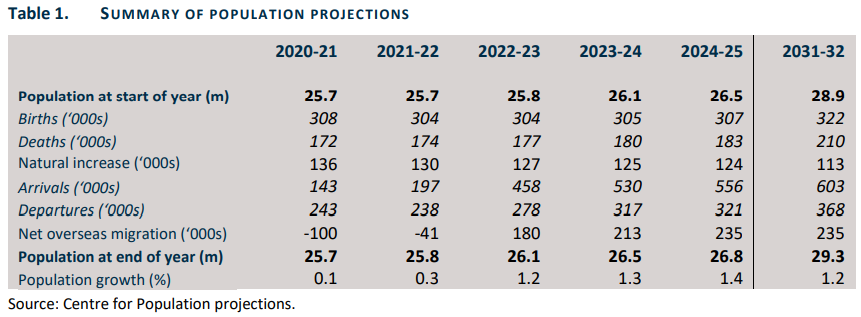
The Intergenerational Report projects that Australia’s population will swell by 13.1 million people (a 50% increase) in only 40 years on the back of 235,000 annual immigration, which will add the equivalent of another Sydney, Melbourne and Brisbane to Australia’s current population:
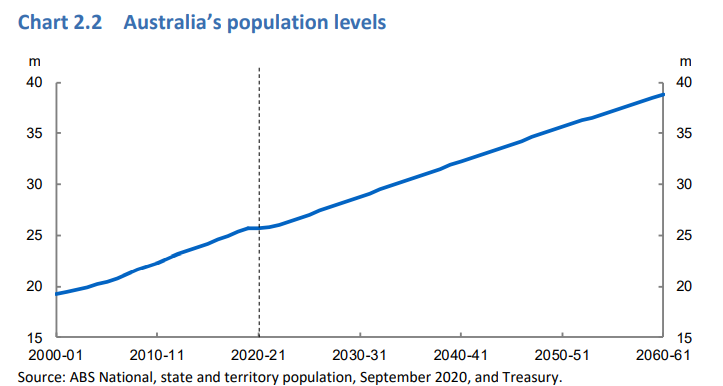
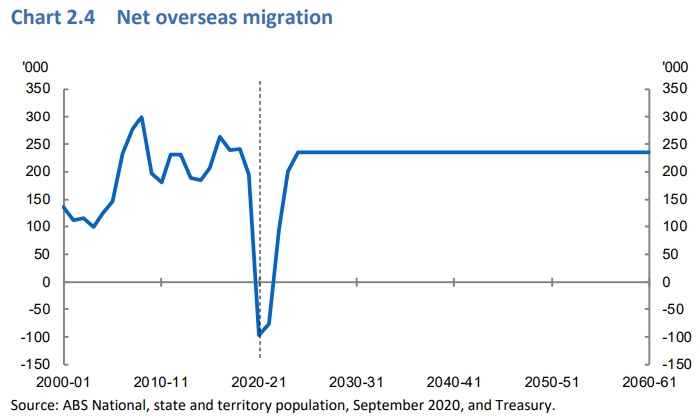
Only in the warped mind of The AFR would a population increase of 3.6 million people in 11 years and 13.1 million people in 40 years be considered a “smaller Australia”.
Next The AFR scaremongers over the worst skills shortages in living memory:
The immediate problem is that there are now 15 per cent fewer skilled visa holders, who usually buffer blows to the economy, than there were before the pandemic. Skills shortages are the worst that anyone can remember…
Hilariously, exactly the same arguments were made by businesses to a Senate Inquiry in 2002:
‘According to the Australian Chamber of Commerce and Industry (ACCI), the lack of suitably qualified staff has been a major concern for Australian industry over the past decade, and is one of the most significant barriers to investment…
‘The Australian Industry Group (AiG) … reports that several industry sectors, including manufacturing, are continuing to experience serious skill shortages which, unless effectively addressed, may have severe and lasting consequences for Australian enterprises…
‘The Business Council of Australia submission points to the risk of future broad-based skill shortages resulting from an ageing population’…
Despite decades of strong skilled migration, whereby literally millions of foreign workers were imported into Australia, industry, the federal government and media continue to make identical claims about chronic skills shortages.
How could this possibly be? How could Australia have such dramatic skills shortages after all these years? And why then is Australian wage growth tracking at close to its lowest level in history if skills shortages are so pervasive? Something doesn’t add up.
Next The AFR repeats the canard that more migrants will rescue the budget and help pay off Australia’s debt:
Without migration, it will prove far harder to grow our way out of the $1.1 trillion in gross debt by 2025, outlined in last week’s midyear economic outlook. Migration usually contributes about 1 per cent of GDP a year, and working-age migrants who become residents put more into government coffers than those born and educated in Australia.
It is migrants who will pay for the ageing of the existing workforce. On top of Australia’s higher debts, the cost of ageing is rising beyond expectations.
The skilled migrant stream only accounts for around 60% of Australia’s permanent migrant intake (including the humanitarian intake). And only around half of the skilled stream are primary skilled migrants, with the rest being migrating family members. All categories of migrants are paid less than the general population, with the only exception being primary skilled migrants. This is shown clearly by the Continuous Survey of Australian Migrants (extract shown below):
Thus, the suggestion that migrants are ‘rivers of gold’ for the budget doesn’t add up.
Moreover, Treasury’s model used to calculate fiscal impacts from migration deliberately ignores costs imposed on state budgets from providing the many goods and services required to sustain bigger populations (e.g. infrastructure, education and social services):
The OLGA [OverLapping Generations model of the Australian economy] and FIONA [Fiscal Impact of New Australians] results presented in this report do not capture the broader economic, social or environmental effects of migration such as technology spillovers or congestion. The FIONA results presented here do not capture the fiscal impacts of migration on state or local governments.
Sadly, the Treasury never takes proper account of the costs of big migration – either financial or non-financial – since these are borne primarily by the states and residents at large.
This explains why the Intergenerational Report banged on incessantly about the rise in healthcare and pension costs from population ageing, but completely ignored the gigantic cost of infrastructure required to house an additional projected 13.1 million people over the next 40 years – the equivalent of adding another Sydney, Melbourne and Brisbane to Australia’s existing population. These infrastructure costs are borne by the state governments and residents (via user charges), so can be dismissed altogether by Treasury.
I bet if the federal government was required to internalise the cost of immigration by paying the states $100,000 per permanent migrant that settles in their jurisdiction, so that the states can adequately fund the extra infrastructure and services required, then Treasury would no longer tout the ‘fiscal benefits’ of immigration.
Making the federal government share the benefits and costs of immigration would be a surefire way of reducing the intake back to sensible and sustainable levels.
Next, The AFR tries to claim that mass immigration is not a ‘ponzi scheme’:
Migration is often miscast as a Ponzi scheme, lazy growth in which migrants service other migrants to produce headline GDP gain that is neither sustainable nor worthwhile. That’s a fundamental misreading of the character of Australia.
Unlike most of its developed peers, Australia is still a frontier economy with untapped resources, and its biggest days in front of it… More people are needed to fulfil that potential…
But a smaller Australia will have a big cost: fewer jobs, fewer houses, less growth and less security too. The great population stall must be short-lived.
Most of Australia’s export income is earned in regional Western Australia and Queensland, whereas the overwhelming majority of Australia’s immigration has landed in the capital cities (especially Sydney and Melbourne).
This immigration, in turn, has driven huge trade deficits in the migrant epicentres of New South Wales and Victoria:
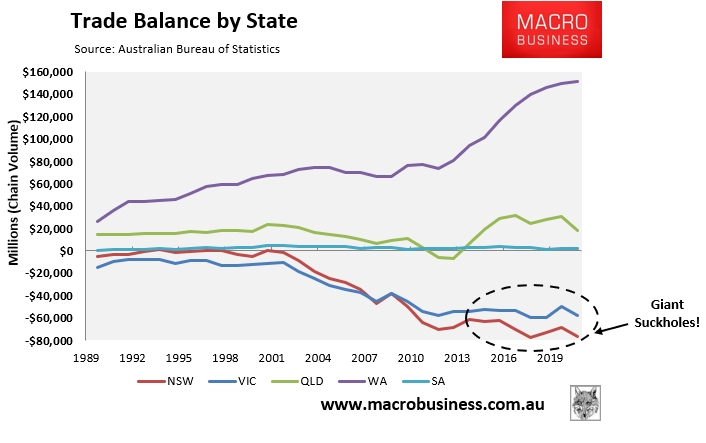
Anybody with a shred of common sense would recognise that sharing Australia’s fixed mineral endowment (and commodity exports) among millions more people will necessarily dilute per capita incomes and living standards (other things equal). It is basic maths.
Does The AFR believe that residents of Brunei, a rich oil-exporting economy, would be wealthier if its population was 1.5 million instead of 500,000 people? The same principle applies to Australia.
The mass immigration program ran in the 15 years pre-COVID also suppressed Australia’s productivity growth, mainly by diverting resources (eg, capital and labour) from the tradable to non-tradable sectors.
Australia has held the pillow over its globally exposed manufacturing and replaced its employment with careers in a never ending housing construction sector that never provides enough homes for Australian housing to become cheaper for Australians.
Tradable goods and services are those that can be sold at locations other than at the place of production (i.e. can be exported overseas). Non-tradable products are those than can only be sold at the place of production (eg, coffees, personal training and haircuts). Tradable firms are typically more productive than other businesses because they benefit from economies of scale and must be competitive against firms both nationally and internationally.
Thus, the diversion of resources resulting from mass immigration encourages growth in low productivity ‘people-servicing’ industries, alongside diverting the nation’s productive effort into houses and infrastructure.
Australia’s economic performance over the pre-pandemic years are consistent with this argument given the fall in both productivity and non-mining business investment as the Australian economy because increasingly concentrated on ‘people servicing’.
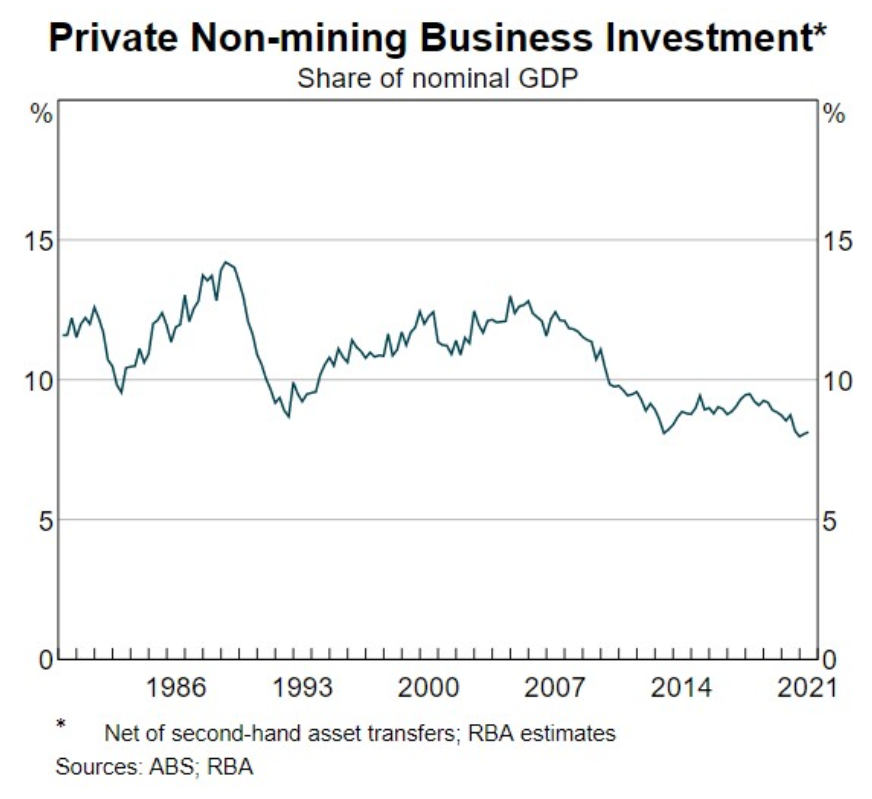
The world has 7.6 billion people. We don’t need to import them to sell to them.
Besides, most Australians do not want a return to pre-COVID levels of immigration, as evidenced by recent opinion polls.
Australians recognise that the mass immigration program of 2005 to 2020 was managed appallingly and crush loaded everything in sight, resulting in widespread infrastructure bottlenecks across Australia’s major cities and reduced liveability.
Sadly, the shills at The AFR shamelessly represent vested interests in the property/business lobby rather than the Australian people.


